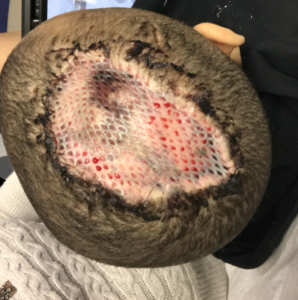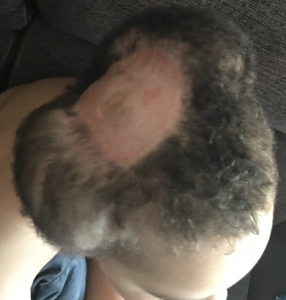Treatment of Dog Bite Injuries and Disfigurement
Our Pittsburgh attorneys have represented hundreds of injured victims. As such, we follow our clients' medical treatment, from emergency care for dog bite wounds through scar revision procedures. We see what procedures have improved the patient's appearance, and which have not.
The purpose of this article is to shed light on certain myths about dog-bite-related treatment and the effectiveness of procedures to reduce scars. We'll cover:
- First, why are bite wounds rarely stitched?
- Second, what options exist to reduce or correct scaring?
- Third, how to learn about possible disease from a particular dog?
Treatment of the Dog Bite Wound
Myth #1:
The number of sutures (stitches) determines how serious the attack had been.
FALSE
A wound requiring numerous stitches (sutures) is serious, no doubt. However, in most dog bite cases, doctors avoid using sutures when possible. Infection can be transmitted from the dog's mouth and sealed into the body, if stitched.
Facial areas are highly vascularized (with blood flow) and heal faster when stitched. Regarding other parts of the body, however, doctors try to avoid the use of sutures given the risk of infection. Thus, there may exist very few sutures in a serious -- or even life threatening -- case.
Puncture Wounds. These are rarely stitched, allowing the wound to drain instead. However, a single puncture injury from a dog's tooth can cause serious damage. For example, our Pittsburgh attorneys have seen a single puncture cause injury to tendons, ligaments, and even nerve damage. Plus, a puncture can also cause a hematoma (a pool of mostly clotted blood) beneath the skin, which can be extremely painful -- limiting one's activities -- and take months to heal.
Fall-Related Injuries. Falling to the ground is dangerous. In fact, it's the #1 cause of traumatic brain injury, ahead of both car accidents and sports injuries. Unfortunately, many dog attacks involve the dog pulling the victim to the ground. As such, in one of our most serious cases, two pit bulls dragged our client to the ground, causing a serious head injury, broken cranial bones, concussion, and permanent hearing loss.
There, no sutures had been utilized.
Scar Revision Options
Myth #2: Plastic surgery or scar revision can fix any scar.
FALSE
Modern medicine is impressive. However, every medical procedure involves the risk of unintended consequences. In fact, many of our dog bite clients decline cosmetic surgery to improve the appearance of a scar, upon learning all the risks of scar revision surgery, including discoloration or raised skin.
For others, there's no choice in the matter of surgery. Often, corrective surgery is necessary not only to improve appearance, but also to restore function. For example, surgery is needed to correct an amputation. The same is true when the attack removes a large area of skin, necessitating a skin graft to restore function. All of that said, below is a description of a few scar revision treatments available.
Surgical Revision or Removal of the Damaged Area
A deep scar can be removed via a surgeon cutting out the damaged tissue; the healthier looking surrounding tissue is pulled together and joined via tiny sutures via microsurgery. The benefits can be dramatic and substantial. Further, the improved appearance can make a difference in the patient's life and wellbeing. However, the risks are also substantial, and include:
-
- making the scar look more red, pronounced, or less natural,
- infection,
- the possibility of keloid scar, which is a thick and raised scar, potentially looking even worse than the dog bite scar; however, some are more prone to keloid scars than others,
- the risk of non-union of the adjoining flesh, especially if the patient is a smoker, and
- pain and recovery time with no real added benefit to the appearance,
Still, it is always worthwhile to consult with a plastic or cosmetic surgeon to evaluate your options, because no information you find online is a substitute for a medical opinion in your particular case.
Skin Grafts
 Here, skin is harvested from another area of the body, then added to an area where a dog had removed an entire section of skin.
Here, skin is harvested from another area of the body, then added to an area where a dog had removed an entire section of skin.
While this surgery does involves risks, like all surgeries, it may be necessary depending on the amount of skin that had been removed by the dog's jaws.
Use of a Tissue Expander
 This involves a device placed beneath the surface of health skin, making it expand for the skin to be harvested for use elsewhere. In one case, doctors described the child patient's procedures as follows:
This involves a device placed beneath the surface of health skin, making it expand for the skin to be harvested for use elsewhere. In one case, doctors described the child patient's procedures as follows:
The reconstruction of soft-tissue damage on the part of the head which is covered with hair is aimed not only at repairing the damage in such a way that it will withstand mechanical strain but also at the restoring the hair on the scalp. In a 5-year-old boy with a scalping injury involving second- and third-degree soft-tissue damage over an area of 20 x 12 cm after a dog bite, surgery was initially performed to transform the damage into purely second-degree damage, which was then repaired with a split skin graft. One year later, the scalp containing the hair was stretched with the aid of two skin expanders over a period of 3 months, so that the split skin graft area could be removed and the hair on the scalp restored.
Laser Treatments
If the dog bite is deep or one's scar is exceptionally large, then a laser treatment may be the best option for that person. The laser operator will target the deepest layers of the skin. Once targeted, the skin is heated up. The idea is to make the skin repair itself through healing, creating the new skin in the process. The downside is, multiple treatments are typically needed to see any improvement.
Chemical Peels
After one's scar has healed for a reasonable amount of time, the person may be a good candidate for a chemical peel. A chemical peel works similarly to laser treatments. Specifically, a chemical peel targets the top few layers of one's skin and causes the layers to peel off. New skin replaces the old as the body regenerates itself — helping to get rid of the scarring in the process. Typically, patients must undergo several chemical peels until they notice real results. Plus, a chemical peel has the risk of new scaring or discoloration to one's appearance.
Topical Treatments
This is the least invasive form of treatment. There are a variety of over-the-counter topical ointments that can be used to get rid of mild scarring. If one has small scar from a dog bite, try using topical ointments like Neosporin when there is a risk of infection, but once the wound is under control, avoid antibiotics to the body or face. Many people develop a skin reaction to antibiotics that can compromise the appearance of skin and make it look worse. Above all, keep the skin hydrated, topical treatments can reduce the likelihood of deep scarring.
Does the Dog Have Rabies?
Myth #3: The police will follow-up to determine whether the attacking
canine had received its vaccinations.
FALSE
According to the Center for Disease Control (CDC):
Rabies is a vaccine-preventable, zoonotic, viral disease affecting the central nervous system. Once clinical symptoms appear, rabies is virtually 100% fatal. In up to 99% of cases, domestic dogs are responsible for rabies virus transmission to humans. Yet, rabies can affect both domestic and wild animals. It spreads to people and animals via saliva, usually through bites, scratches or direct contact with mucosa (e.g. eyes, mouth or open wounds). Children between the age of 5 and 14 years are frequent victims.
All that said, it is not the police who do the "dog bite report" or follow-up to see if the biting dog has rabies.
Pennsylvania's Dog Bite Law gives the county health department (animal control) -- not the police --- jurisdiction over dog bite cases and law enforcement in dog bite cases. It is animal control's job to:
-
- Evaluate whether the dog might have rabies or some other infectious disease
- Quarantine the dog if necessary,
- Create an animal bite report
- Bring charges against the dog owner for a "dangerous dog" or the failure to control the animal, and
- Attend criminal court to advance the above charges.
Therefore, immediately following a bite, you should contact your county's health department to confirm that a claim has been opened to evaluate the dog at issue.